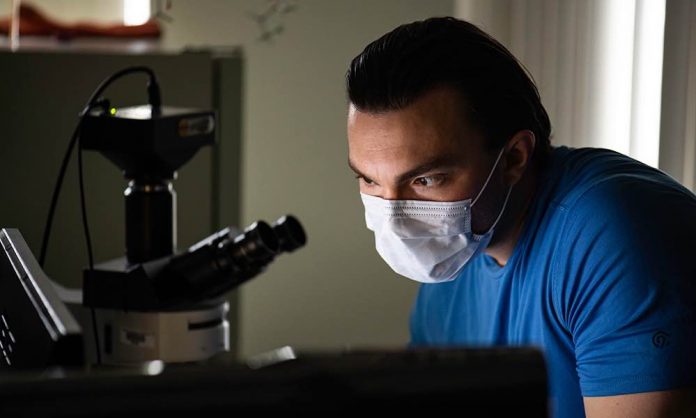But HIV is a tricky virus. It can adapt to your current medication, causing your infection to worsen and eventually become fatal.
Luckily this can be avoided with a blood test every three to six months that monitors the viral levels in your blood and indicates if your current medication starts to fail.
Unfortunately, you are one of the 25 million people living with HIV in a region of the world that doesn’t have the resources to perform this test, because it requires expensive medical equipment and trained medical professionals.
My thesis is that this life-saving blood test can be performed in low-resource settings by combining paper-like materials and ant-like molecular probes to create a cost effective and user friendly device for monitoring HIV in the blood.
My thesis has two primary objectives. The first is to passively prepare the blood sample. For this I have adapted a technique developed by our collaborators that separates viruses from whole blood, using a stack of paper-like filters. When the blood sample is applied to the top filter, the liquid gets sucked through each of the layers, like a sponge sucking up water. Each layer is modified with different physical and chemical properties that allow it to separate the virus from the blood, break the virus particle into pieces, and then capture the pieces for detection.
This allows the sample to be prepared in a completely self-contained environment, eliminating the need for trained medical professionals.
The second objective is to detect the HIV particles. For this, I want you to consider my image of ants at a picnic. In the image on the left, the food is first laid out for the picnic and the ants are just wandering in the area, pretty randomly and chaotically. But as shown on the right, it only takes a single ant, locating the food, to set up a cascade reaction that draws in more of the ants.
In the context of my research, the ants are molecular probes that I have engineered to locate HIV particles. Like the ants, these probes wander randomly until a single probe locates an HIV particle, which sets off a cascade reaction that draws in more of the probes. From my research, I have found that a single viral-like particle can attract over one hundred probes, and each probe is equipped with its own fluorescent beacon.
This means I can detect very small amounts of virus without the need for expensive medical equipment.
The completion of this device will empower millions of people living with HIV with the ability to monitor their health—even if they live in a low-resource community.
Two combat tours in Iraq brought Jeffrey Beard face to face with “reproachful disparities” between the United States and developing countries, he says.
Beard, the winner of this year’s virtual Three Minute Thesis Competition at the University of Rochester, is helping to confront one of those disparities. The biomedical engineering PhD candidate in the research lab of Benjamin Miller is developing a more affordable way to monitor the condition of 25 million people living with HIV in resource-limited countries. They do not have access to the more expensive testing used in other parts of the world.
“Dr. Miller gave me the opportunity to ‘declare war,’ if you will, on health care inequality by introducing me to point-of-care diagnostics designed for people who desperately need them,” Beard says.
He won over the judges and nearly 200 audience members with an easy-to-understand description of the HIV viral load test that he’s developing, earning him the $750 first-place prize and the $250 people’s choice award.
Ian Krout, a toxicology PhD candidate in the lab of Matthew Rand, won the second-place prize of $500 for describing his efforts to identify the microbes in our gut microbiome that could help protect us from methylmercury toxicity after ingesting fish.
The annual competition stresses the importance of being able to communicate research clearly and in a way that is understandable to the general public. The nine finalists were each given three minutes—and a single slide—to summarize their projects.
The judging focused on key elements of comprehension and communication—for example, the ability of presenters to avoid scientific jargon, maintain eye contact, and convey enthusiasm.
Beard managed to do that despite the confines of a Zoom presentation and having to share the screen with a dominant image of his slide.
Molecular probes—or ants around the cheese platter
His technology would allow whole blood drawn by a finger prick to be inserted in a capillary-driven testing device that separates serum from the blood. The testing device is then inserted into a reader that optically detects HIV particles in the serum. The results are displayed on a smartphone camera.
Beard used analogies to describe how the technology works. For example, like ants swarming randomly near a cheese platter at a picnic, he explained, molecular probes in his device “wander randomly until a single probe locates an HIV particle, which sets off a cascade reaction that draws in more of the probes.”
“Science is for everyone, and we aren’t doing our work any justice if we can’t communicate our science in a way that gets people excited about it,” he says.
The annual competition is sponsored by the sponsored by the School of Medicine and Dentistry myHub, the Arts, Sciences & Engineering Graduate Education and Postdoctoral Affairs Office, the Graduate Student Society, and the Graduate Student Association.








